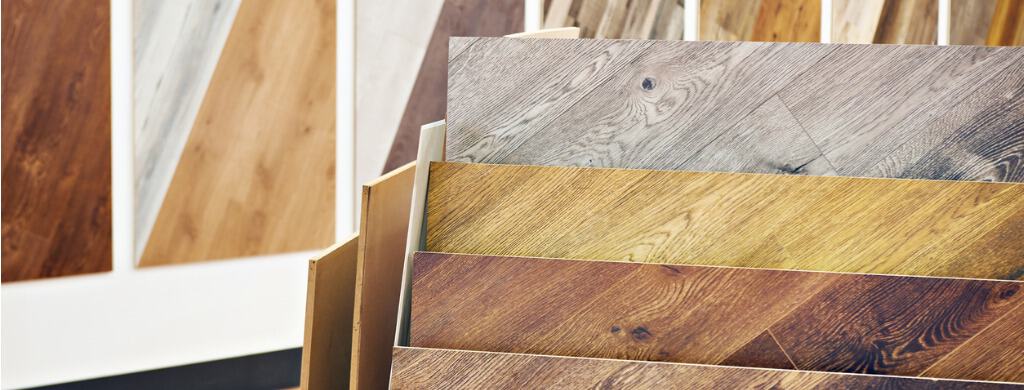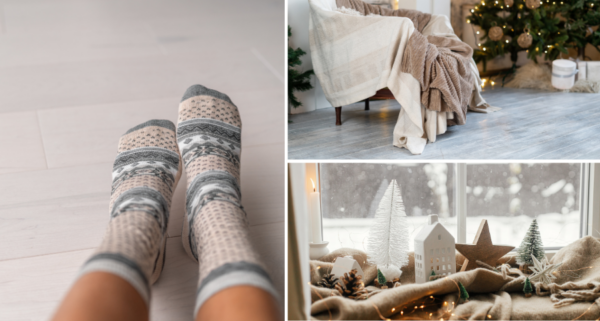The flooring industry has changed a lot over the years. From different carpet fibres to entirely new types of products, it can be hard to know what flooring is best suited for your project. Because flooring isn’t something we think about every day, we’ve put together this guide to flooring choices to help your decision-making process. We’ve broken it down by product category and have included tips on the installation, durability, maintenance, costs, and the benefits of each type of product.
Of course, if you have any questions, you can reach out to your local Nufloors for help.
Table of Contents
- Types of Flooring
- Carpet Flooring
- Hardwood Flooring
- Luxury Vinyl Flooring
- Sheet Vinyl Flooring
- Laminate Flooring
- Cork Flooring
- Tile Flooring
- Natural Stone Flooring
- How to Choose the Right Flooring For Your Home
- Cost: Which Flooring Option is Most Economical
- Installation: How to Measure Your Space
- Replacement: How to Match Discontinued Flooring
- Flooring Maintenance Tips
- Conclusion
Types of Flooring
Carpet Flooring
Traditionally, carpet has been one of the most common types of flooring found in Canadian homes because of the number of benefits associated with carpet. We get into those benefits shortly, but first we must understand the technical side of carpet.
There are five main fiber types that carpet is made from, which all perform and look slightly different. It is important to choose the right fiber for your household and lifestyle.
The five fibers are:
- Nylon: very versatile and provides excellent durability.
- Polyester: the best for retaining its colour and won’t fade over time. It is soft to the touch but not as durable as Nylon and should be installed in low to medium traffic rooms.
- PPT (Triexta Polyester): the newest fiber on the market. It is naturally very stain resistant, resilient and is softer than both polyester and nylon.
- Polypropylene (Olefin): relatively inexpensive with superior stain resistance plus it is solution-dyed so it is resistant to bleaching and sunlight fading. The downside to it is that it is not as resilient as other fibers and therefore, won’t “bounce back” after being compressed by foot traffic.
- Natural Fiber (Wool): the premium carpet fiber on the market. It is natural, sustainable & renewable. It also improves indoor air quality, is fire retardant, helps regulate humidity and is a natural insulator, which helps reduce heating and cooling costs as well as absorbs sound. However, wool does require specific maintenance, i.e. an appropriate vacuum and spot removal methods.

Carpet Flooring Pros:
- Carpet is cushiony and warm, which makes it perfect in family rooms and bedrooms, especially for children or older residents.
- Can create a more peaceful environment as it helps reduce noise from dropped objects and footsteps.
- It is hypoallergenic and improves air quality.
- There are pet friendly options now available.
Carpet Flooring Cons:
- Carpet is not suitable for wet areas such as kitchens, laundry rooms and bathrooms. If you are looking for a seamless look throughout your entire home, carpet would not be an option.
- Susceptible to stains from spills. Even with stain-resistant treatments, spills must be addressed promptly to avoid permanent damage.
- High-traffic areas can show signs of wear and tear more quickly with carpet than with other types of flooring. Carpets can mat down and lose their plushness over time.
Hardwood Flooring
The natural elements and beauty of a hardwood floor makes it a timeless, highly sought after choice, proven to increase the value of a home (WFA link)
Hardwood flooring is available in two forms: solid hardwood and engineered hardwood. Knowing the difference is important as the make-up and performance of the two are different. Hardwood is also available in a wide variety of different wood species which vary in hardness and will affect durability.
Solid hardwood is 100% solid planks whereas engineered hardwood has a stable, layered construction with a wood top and backing. Hardwood is not only durable, but it can be sanded and refinished over the years, making your investment last.

Hardwood Flooring Pros:
- Adds to the resale value of your home.
- Hardwoods durability and long-lasting performance is what homeowners value.
- Offers a timeless, elegant look that enhances the beauty of a home and can last a lifetime
- Complements various decor styles, from traditional to modern.
- Hardwood floors do not trap dust, pollen, and other allergens, and may contribute to better indoor air quality.
- Depending on the product, it may be refinished.
Hardwood Flooring Cons:
- Hardwood is highly susceptible to moisture (however, engineered hardwood is designed to be more stable).
- May be expensive to purchase and install, especially if high-quality or exotic wood types are chosen.
- Require regular maintenance such as sweeping, vacuuming, and occasional refinishing to keep them looking their best.
Luxury Vinyl Flooring
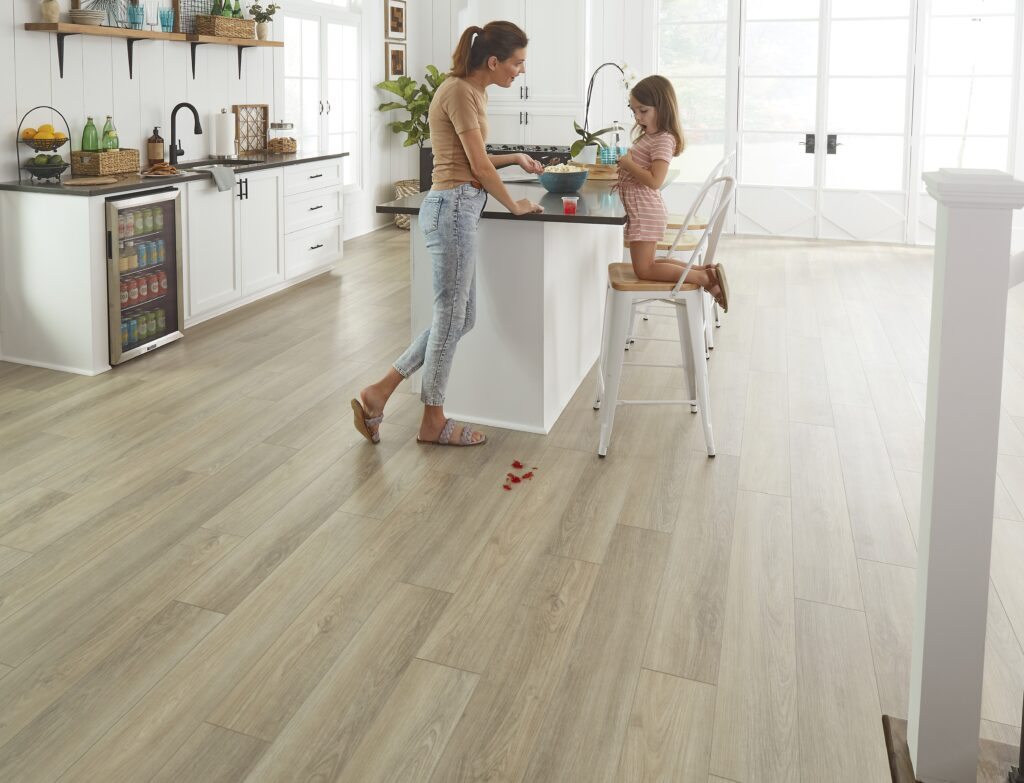
Luxury vinyl flooring is the newest type of flooring on the market. Designed to resist moisture and everyday wear and tear, it is built to withstand even the busiest of lifestyles. And with today’s technology, luxury vinyl can fool even the biggest critics with its realistic visuals and texture of hardwood and stone.
Its construction consists of multiple layers:
- Wear Layer – can vary in thickness but is designed to provide resistance to scratches, stains and wear.
- Design Layer – high quality printing technology that creates realistic visuals of wood, stone or tile.
- Core Layer – This layer provides the stability and resilience. There are different types of cores, i.e. Flexible or Rigid, which can be either SPC (Stone Plastic Composite) or WPC (Wood Plastic Composite).
- Backing Layer: Adds additional support and can include an attached pad for extra comfort and sound absorption.
Luxury Vinyl Pros:
- Suitable for installation in any room in the house including the wet zones & high-traffic areas.
- There are many water-resistant options.
- DIY friendly compared to real hardwood, tile or stone.
- Wide range of style options with realistic patterns.
- Easy to clean and maintain.
- A great choice for homes with pets.
Luxury Vinyl Pros:
- Quality can vary between brands and product lines.
- It is made from synthetic materials like PVC, which may release volatile organic compounds (VOCs) into the air. The amount of VOCs released can vary depending on the quality of the flooring, the manufacturing process, and the specific materials used.
- Some manufacturers offer low-VOC or no-VOC products to reduce the potential for indoor air pollution. It’s a good idea to look for certifications such as FloorScore or GREENGUARD, which indicate that the flooring meets strict indoor air quality standards.
- Unlike natural materials such as hardwood or stone, luxury vinyl is not biodegradable and can contribute to landfill waste when disposed of.
Sheet Vinyl Flooring
Sheet vinyl flooring is a continuous, large sheet of flooring material made from vinyl. Typically, available in widths of 6, 12, or even 13 feet, allowing for fewer seams in large rooms. It is a popular choice for residential applications due to its affordability, durability, and ease of maintenance.
Sheet Vinyl Pros:
- Affordable and generally less expensive than other flooring options.
- The original water-resistant floor. With fewer seams, water is less likely to penetrate to the subfloor.
- Durable and resistant to scratches, dents, and stains.
- Easy to clean and maintain with a simple sweep and mop. No special waxes or polishes are needed.
Sheet Vinyl Cons:
- Subfloor imperfections can show through the vinyl so proper subfloor prep is crucial before installation.
- Professional installation is needed.
- While practical and stylish, it may not add to the resale value of a home.
Laminate Flooring
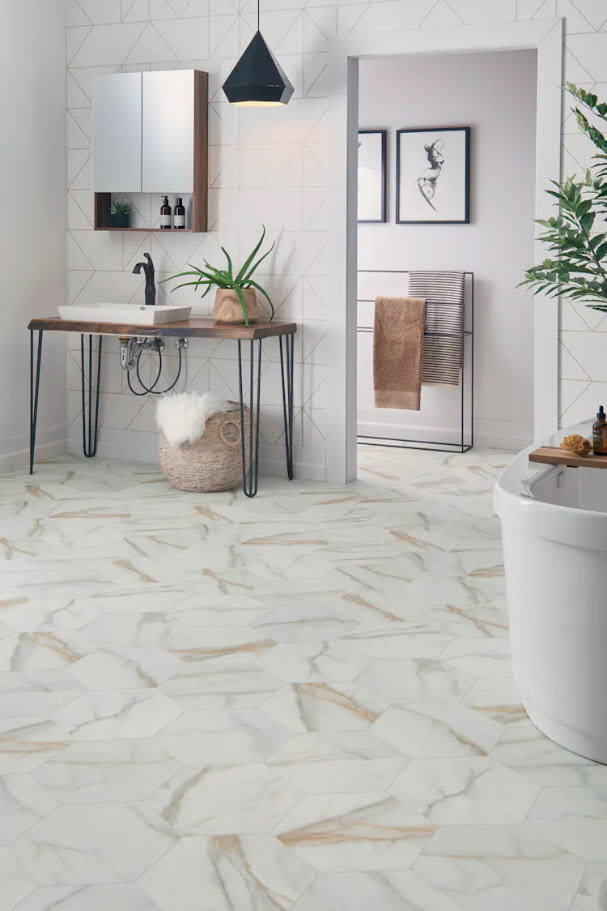
You can achieve the look and feel of hardwood or high-end stone on a budget with laminate flooring. This is a hardworking floor ready to take on the challenges of a busy family.
Similar to Luxury Vinyl, laminate also consists of 4 layers:
- Wear Layer – The top layer provides resistance to scratches, stains, and fading. It’s made from a clear, durable plastic called melamine resin.
- Design/Pattern Layer – Contains a high-resolution photographic image that mimics the appearance of wood, stone, or other materials.
- Core/Substrate Layer – Made from high-density fiberboard (HDF) or medium-density fiberboard (MDF). This layer provides stability and impact resistance.
- Backing Layer – The bottom layer provides additional support and stability, preventing moisture from penetrating the core layer.
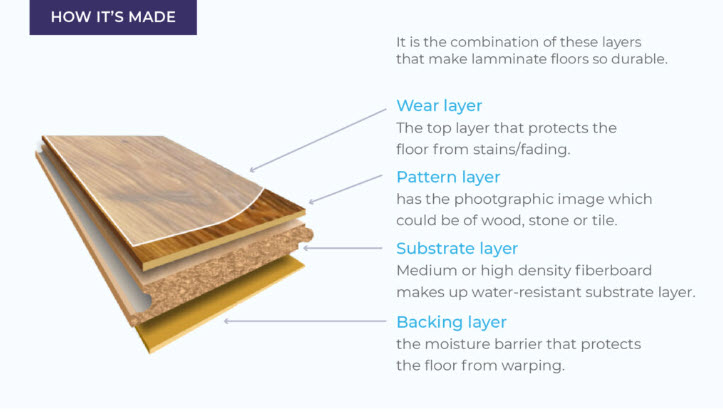
Laminate Pros:
- Highly resistant to scratches, dents, stains, and fading making it suitable for high-traffic areas.
- Generally, less expensive than hardwood, tile or stone.
- Available in a wide range of designs, colours, and textures that mimic natural materials.
- DIY friendly with click together installation systems.
Laminate Cons:
- Not as water-resistant as luxury vinyl, sheet vinyl or tile. Prolonged exposure to water or standing moisture can cause damage, such as warping or swelling. However, there are new laminates that now offer water-resistant qualities.
- May produce a hollow sound when walked on. Underlayment can help reduce noise and add cushioning.
- While durable, it may not last as long as hardwood or tile. The lifespan is typically 10-25 years, depending on quality and usage.not add to the resale value of a home.
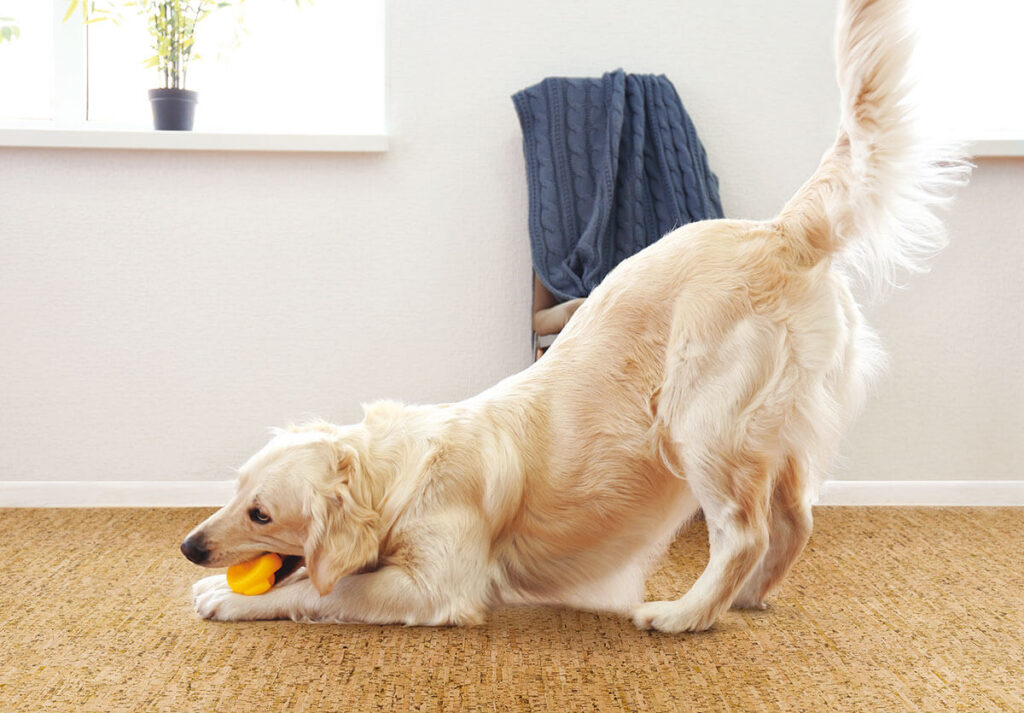
Cork Flooring
Cork is made from the harvested bark of cork oak tree (the trees are not cut down), which regenerates, making it a renewable resource. It is also biodegradable and recyclable making it one of the most eco-friendly flooring options on the market. To produce the floor the cork is grounded up, compressed, and formed into sheets bonded with resins.
Its unique properties, including thermal and acoustic insulation, comfort underfoot, hypoallergenic, and stylish designs, make it an appealing choice for homeowners.
Cork Flooring Pros:
- One of the most sustainable flooring options on the market.
- Superior comfort with natural shock-absorbing properties, which can be easier on the joints and back.
- Provides excellent thermal and acoustic insulation, helping to maintain room temperature and reduce noise.
- Durable to wear and tear, it has a natural ability to bounce back from minor indentations and impacts.
- Hypoallergenic as it is resistant to mold, mildew, and termites.
- Absorbs Co2 from the atmosphere and some selections are PVC free.
Cork Flooring Cons:
- While cork is water-resistant, it may be damaged by excessive moisture. Some companies require proper sealing to prevent water damage.
- Prolonged exposure to direct sunlight can cause cork to fade or discolour. Window treatments or UV-resistant finishes can help mitigate this issue.
- While durable, cork can be susceptible to scratches and dents from sharp objects or heavy furniture. Using furniture pads and area rugs can help protect the surface.
- Requires regular cleaning and occasional resealing to maintain its appearance and durability.
Tile Flooring
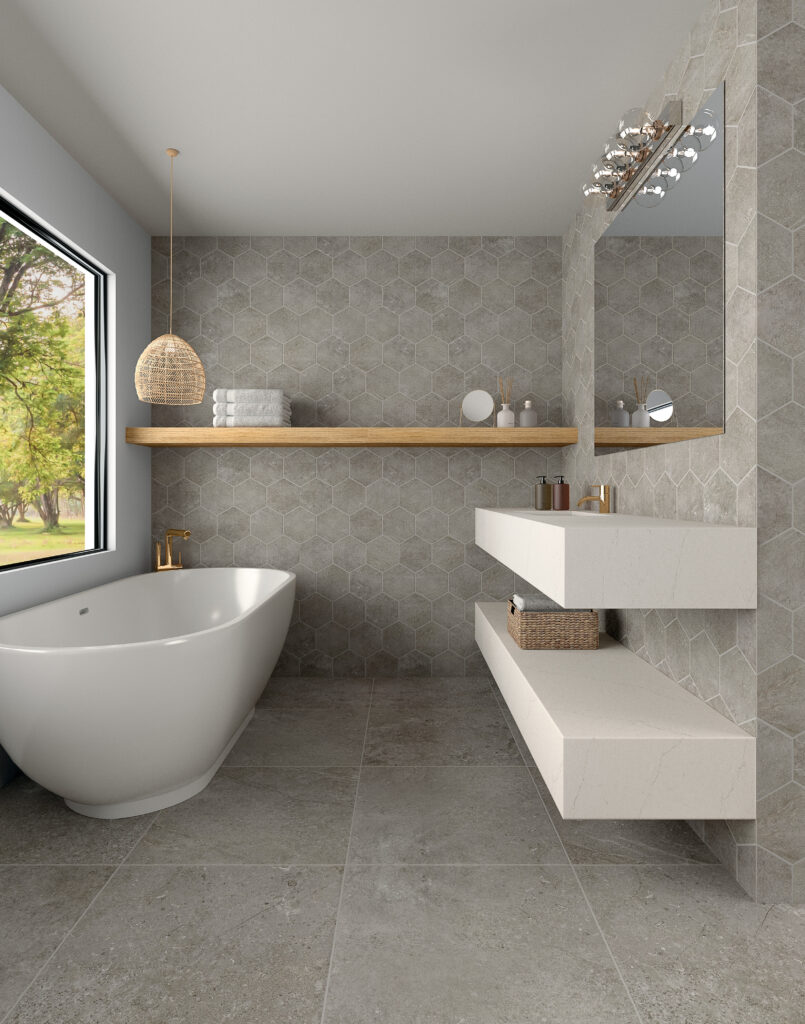
Tile is available in all shapes, colours and sizes and can be installed in a variety of different patterns and layouts to create truly unique designs. It can also be installed anywhere, even places you may not initially think, such as on the back of islands or to create an accent wall. Homeowners love tile as it allows them to be creative and lets their personal style shine.
There are four types of tile, which include:
- Ceramic: This type of tile is made from clay and other natural materials, fired in a kiln and finished with a glaze to add colour and protect the surface.
- Porcelain: Porcelain is made from refined clay and fired at higher temperatures, which makes it more dense, durable and less porous than ceramic tile. Porcelain is suitable for both indoor and outdoor use, whereas ceramic is only suitable for indoor applications.
- Glass: Made from thin pieces of glass, this type of tyle is often used for decorative accents, backsplashes and mosaics.
- Mosaic: These are made from smaller pieces of tile, either ceramic, porcelain, glass or stone to create intricate patterns and designs. They are often found as backsplashes, shower floors and niches, or decorative accents.
Tile Flooring Pros:
- Highly durable and water resistant, which makes it ideal for high-traffic and water prone areas such as bathrooms, kitchens and basements.
- The tile itself is easy to clean and maintain (grout maybe not so much…)
- Huge variety of colours, patterns styles and sizes to choose from.
- Tile does not harbor allergens making it a good choice for those with allergies.
Tile Flooring Cons:
- Grout can be tricky to clean, and it requires resealing periodically to prevent staining.
- Not as cozy and warm underfoot compared to other flooring options. However, you can make tile more comfortable by installing overtop of radiant heating.
- The hard surface can be uncomfortable to stand on for long periods of time and is less forgiving to fallen objects.
- Depending on the finish, i.e. glossy, they can be particularly slippery when wet.
- Some types of tiles, i.e. ceramic, are not as durable as others and can be prone to chipping.
- Installation can be labor intensive and time consuming, often requiring professional help.
Natural Stone Flooring
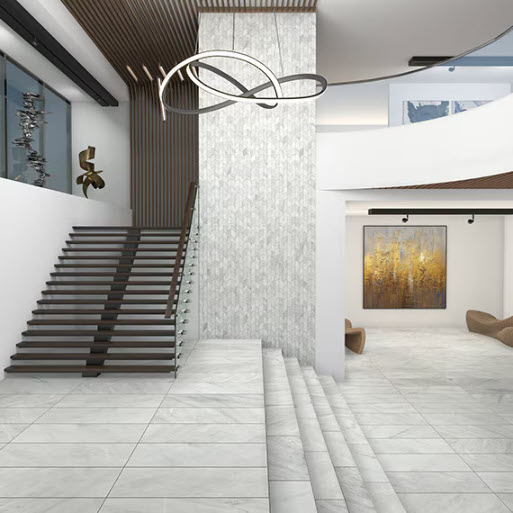
Natural stone has 5 different types:
- Marble: Who doesn’t love the look of luxurious marble? It is elegant and is available in a wide range of colours and veining patterns.
- Granite: Granite is extremely durable and resistant to scratches and heat making it ideal for high-traffic areas.
- Slate: It has a distinctive texture and rich colour variation, but it is durable and slip-resistant, making it suitable for indoor and outdoor use.
- Travertine: Travertine is characterized by its porous surface and natural earth tones; it does however require sealing due to its porous nature to protect again stains and moisture.
- Limestone: This is the softest and most porous stone, which requires it to also be regularly sealed. It offers a natural and rustic appearance.
Natural stone exudes timeless beauty and elegance, with each piece offering unique patterns and textures that add character to any space. It is highly durable making it suitable for high-traffic areas and can also be used in a variety of applications both indoor to outdoor patios. Seamlessly blending indoor and outdoor living. Natural stone is sure to increase the value of your home thanks to its luxurious appeal and natural, one of a kind aesthetic.
Natural Stone Pros:
- Aesthetic appeal that adds natural beauty to any space.
- Extremely durable and long lasting as it can withstand heavy use.
- Will increase the value of your home thanks to its timeless appeal and durability.
- Available in a wide range of colours, textures and finishes.
Natural Stone Cons:
- Natural stone is generally more expensive than other flooring options both in terms of material and installation as it is not recommended to install yourself.
- Limestone and travertine are more porous and can absorb liquids, which leads to stains if not properly sealed and maintained.
- Natural stone is heavy and requires a sturdy subfloor.
- Because it is a natural product from our environment, the variation in colour and pattern can be a disadvantage if a uniform look is desired.
How to Choose the Right Flooring for Your Home
Flooring isn’t something you buy everyday plus it is an investment, so how do you ensure you are selecting the right flooring for your home and needs? Consider the following factors:
- Lifestyle and Use
- Foot Traffic: High-traffic areas such as hallways, stairs, kitchens and living/family rooms require a durable floor that can withstand wear and tear.
- Pets and Children: If you have a busy household with children and/or pets, you’ll need a floor that is scratch resistant and easy to clean.
- Room Function: Different rooms have different requirements. i.e. bathrooms, kitchens and laundry rooms need to be water-resistant, while bedrooms might benefit more from the warmth and comfort of carpet.
- Budget
- Cost of Materials: The price of flooring varies depending on the material. Hardwood and natural stone, for instance, are more expensive than laminate or vinyl.
- Installation Costs: Some types of floors are more labour intensive and require a skilled professional such as carpet, hardwood, sheet vinyl and tile, which will increase the overall costs, while others are more DIY friendly making it more affordable. Also, some materials require additional materials, such as tile and grout.
- Maintenance and Longevity: Consider the long-term maintenance costs and lifespan of the flooring. Some materials may have a higher upfront cost but lower maintenance costs. Hardwood for instance, can be sanded and re-stained 1-2 times in its lifespan. Other types of floors such as laminate or vinyl will need to be replaced every 10+ years depending on your lifestyle and how well you maintain them.
- Aesthetic
- Style and Design: It is important to choose a floor that complements the overall design and colour scheme of your home as it impacts the mood and atmosphere of a room.
- Texture and Finish: Each type of flooring provides a different texture and unique sensory experience which affects both appearance and feel underfoot. For example, carpet provides a soft plush feel making a space feel warm and inviting. Hardwood, on the other hand, is available in a number of different textures and finishes such as hand scraped and wire bushed, which offers different benefits and unique looks.
- Comfort and Insulation
- Underfoot Comfort: As we just mentioned, carpet provides the most comfort and cushion underfoot. The other type of flooring that is quickly making its way to the top of the list for comfort is cork. It has natural cushioning that reduces the impact on feet and joints.
- Sound Insulation: Different types of flooring will provide different levels of sound insulation. Again, carpet and cork will help reduce noise while tile, laminate, hardwood or luxury vinyl may amplify it.
- Thermal Insulation: Certain floors will actually help keep your home warmer in the winter and cooler in the summer. Again, cork is at the top of this list with natural thermal properties thanks to its cellular structure. Engineered hardwood and vinyl with insulating underlayment are also smart options.
- Durability and Maintenance
- Wear and Tear: Select a flooring material that is durable enough to withstand the demands of the area it will be installed in. This will ensure it lasts for much longer and does not need to be replaced as quickly.
- Maintenance Requirements: Some floors can be very low maintenance such as laminate and luxury vinyl as they only require a basic cleaning schedule (to ensure long term longevity), while others like hardwood and cork may require refinishing (however these refinishes extend the longevity of your flooring).
- Environmental Impact
- Sustainability: Fortunately, there are now several eco-friendly options available, including cork, wool carpet, hardwood, and natural stone, all of which are made from renewable resources. There are also several eco-friendly laminate, vinyl, and carpet products designed with more sustainable manufacturing processes, such as using recycled materials or being PVC-free.
- Indoor Air Quality: Look for materials with low VOC (Volatile Organic Compounds) to ensure better indoor air quality or opt for cork, solid or engineered hardwood or tile.
- Moisture Resistance
- Water-Resistant: For those water prone areas, like bathrooms, kitchens, laundry rooms or basements, it is important to go with a material that is water-resistant, such as tile, laminate or luxury vinyl.
- Humidity Considerations: Understanding the climate of the place you reside is important to consider, especially if you are leaning towards hardwood as it can warp or buckle in high humidity. Care should be taken to maintain a humidity level within the 35-55% range.
Cost: Which Flooring Option is Most Economical
Each flooring material varies in cost and suitability, so it’s important to consider your overall budget, preferences, and specific needs. The most economical option will differ for each homeowner but should strike a balance between affordability, durability, and aesthetics. Here is a general list of materials ranked from least to most expensive. Keep in mind that within each category, the quality of materials can vary significantly, which can greatly influence the cost.
Note: cost estimates shown do not include professional installation.
- Sheet Vinyl ($1.25 – $6/sf): Available in a wide variety of modern and trending styles. The original “water-resistant” flooring, it is quick to install and easy to maintain.
- Carpet ($2 – $15/sf): Great for insulation and comfort although it does require more maintenance and is less durable in high-traffic areas. It is recommended to be installed by a professional.
- Laminate Flooring ($2.50 – $10/sf): Another budget friendly alternative to hardwood, offering a similar appearance and texture. Laminate flooring can be installed either by a professional or as a DIY project.
- Luxury Vinyl ($3 – $12/sf): Offered in a number of different styles including looks that mimic hardwood, tile and natural stone. It is more affordable than the real options and can be installed yourself if you are handy.
- Tile ($3 – $20/sf): Durable, water resistant and available in a huge array of styles, patterns and colours allowing your unique style and creativity shine. For best results and longevity, professional installation is recommended.
- Engineered Hardwood ($5 – $15/sf): More affordable than solid hardwood and is more stable and less prone to warping. However, as it is made up of different layers, it cannot be refinished as many times as solid hardwood can. It will add value to your home though.
- Cork ($6 – $10/sf): Eco-friendly and provides natural thermal and sound insulation.
- Solid Hardwood ($7.50 – $20/sf): Solid hardwood is also guaranteed to add value to your home. However, it does require more maintenance and is more expensive to install.
- Natural Stone ($8 – $20/sf): Durable and luxurious with unique patterns and textures. Often used in high-end applications as it requires professional installation and sealing.
Installation: How to Measure Your Room for Flooring Installation
Precisely measuring a room involves several steps and is crucial to ensuring the correct amount of flooring material is ordered, therefore we highly recommend you contact your local flooring expert to ensure accurate measurements (did you know Nufloors offers a free in-home measure and estimate? Take advantage of our service and contact us today!) If you decide to measure your space yourself, the tools you need include a tape measure, notepad and pen/pencil, and a calculator.
Installing Carpet & Sheet Vinyl
- Step 1: Measure the length and width
Start by measuring the length and width of the room at the longest points. If the room is irregularly shaped, divide the room into square or rectangle sections and measure each section separately. Write down the measurements in feet and inches. - Step 2: Add extra for doorways, closets and alcoves
Measure the areas where there are doorways, closets and alcoves or other features that need flooring separately and add them to the main measurements during step 3. - Step 3: Calculate the square footage
Multiply the length by the width of each section to get the square footage. For example, if the room is 12 ft long by 10 ft w, the area is 120 square feet. Then add the square footage of any additional areas, such as doorways, closets and alcoves, to the main area. - Step 4: Determine the roll width
Rolls typically come in standard widths of 12 feet. Knowing the width of the roll will help determine how much flooring to order. - Step 5: Calculate total material needed
Divide the total square footage by the width of the roll to determine how much linear feet of material you will need. For example, if the room is 120 square feet and the roll is 12 feet wide, you will need 10 linear feet (120 ÷ 12 = 10). - Step 6: Add extra for seams and pattern matching
It’s good practice to add 10-15% extra to your measurements to account for waste, seams, and pattern matching. For patterned carpets or sheet vinyl, you may need more depending on the size of the repeat pattern. - Step 7 (Carpet): Consider the direction of the carpet pile
When it comes to carpet, take into account the direction of the carpet pile. In some cases, the carpet may need to be laid out in a specific direction, which can affect how much you need.
Order Calculations Example:
Room Dimensions:
Length: 15 feet
Width: 10 feet
Closet: 2 feet by 3 feet
Calculations:
Main Room: 15 x 10 = 150 square feet
Closet: 2 x 3 = 6 square feet
Total Area: 150 + 6 = 156 square feet
Carpet Roll Width: 12 feet
Linear Feet Needed: 156 ÷ 12 = 13 feet
Add 10% Extra: 13 + 1.3 = 14.3 feet
Order: 15 linear feet of 12-foot-wide carpet.
Installing Plank & Tile Flooring
- Follow Steps 1 to 3 as per above.
- Step 4: Add for extra waste
Add 10% to your total square footage to account for cuts, mistakes, and future repairs (It is suggested to keep an extra box on hand to make repairs in the future if necessary). For irregular rooms that require many cuts and angles, you may want to consider adding 15%. - Step 5: Consider the direction of the planks or layout of the tile
Before ordering any flooring material, you will want to decide on which way the planks will run as this can affect the amount of flooring needed due to layout and cutting requirements. Same with tile, if you are going for a pattern installation, you will need to account for required cuts and waste.
Installation Tips:
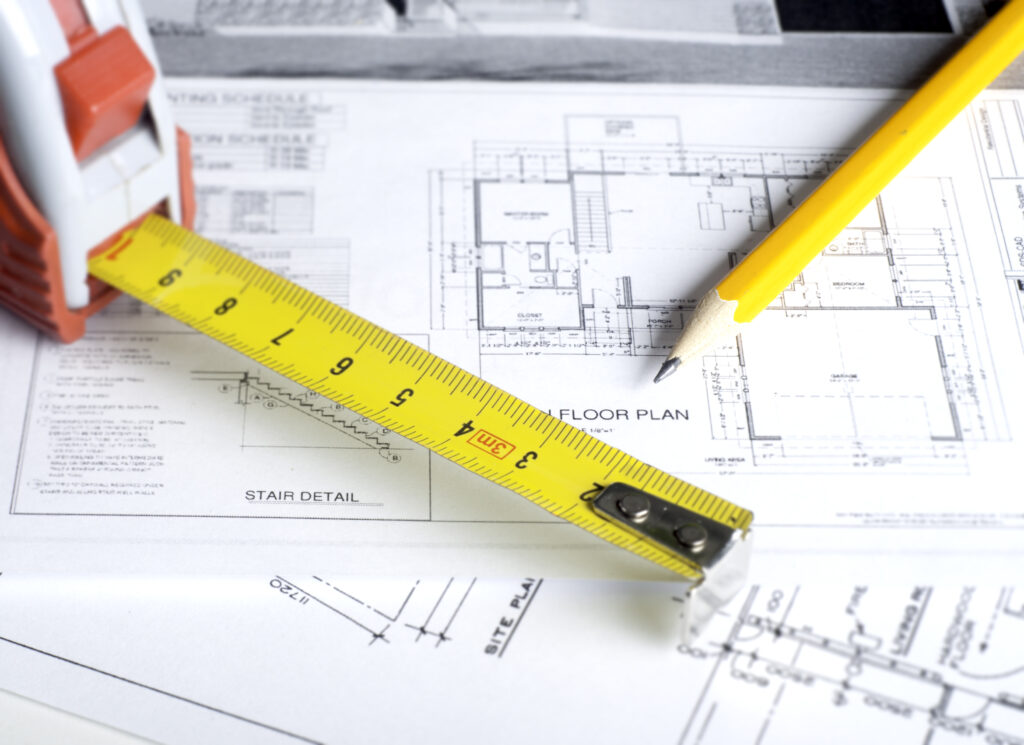
- Double / triple check your measurements to avoid ordering too much or too little material.
- Take note of any obstacles such as built in furniture or steps that may affect the installation.
- For plank flooring, check the plank width of the flooring you are purchasing. This will help you estimate the number of boxes you will need to order.
- Unless you are experienced with measuring and ordering flooring, it is always recommended to check with a flooring expert to confirm the amount of flooring required. The last thing you want is to be in the middle of your installation and run out of your flooring material or have lots of material left over.
Flooring Installation FAQs
How much extra flooring should I order?
As we mentioned, it is good practice to add 10 – 15% to your total square footage for all flooring materials. This will account for off-cuts, waste and mistakes. Also, when it comes to flooring on rolls (Carpet & Sheet Vinyl) especially with a pattern, more may need to be ordered to ensure the pattern lines up when seams are involved. For plank flooring it is smart to order enough extra that you end up with an extra box at the end of installation, this will allow you to make repairs down the road when and if needed.
What factors should I consider when installing new flooring?
- What condition is your subfloor in? – A sound subfloor is integral to the longevity of your floor. It is the foundation of any good flooring installation regardless of the type of flooring as it helps your floor keep its integrity. Before installing and new floor, check your subfloor for imperfections and make necessary repairs. The subfloor must be clean, dry and smooth before laying down your floor. In most cases and with most products, the subfloor must also be level.
- Is an underlayment or underpad required? – Underlayment is usually recommended for laminate and luxury vinyl to provide cushioning; this helps reduce noise and adds another layer of moisture protection for the subfloor.
What are the different types of installation methods for hard surface floors?
Luxury vinyl can either be glued down or can be floated with a click-lock installation. Laminate is a floating floor which includes a click-lock installation. Hardwood, depending on if it is solid or engineered will vary, i.e. solid hardwood is typically glued or nailed down, whereas engineered can be glued or nailed or floating using a click-lock system.
Do I need a carpet cushion?
A good quality carpet cushion is essential to ensure your new carpet performs and lasts for years to come. It acts as a buffer between the carpet and the subfloor, allowing fibers to bounce back and retain their appearance. It also helps your carpet feel better underfoot and absorbs sounds to reduce noise. In fact, a lower quality carpet will perform, look and feel better with a high-quality underpad, versus a high-quality carpet with a low-quality pad.
How should floor seams be managed?
Seams, if necessary, should be placed in low-traffic areas and if it is a sheet vinyl installation, they should be sealed properly to prevent water infiltration.
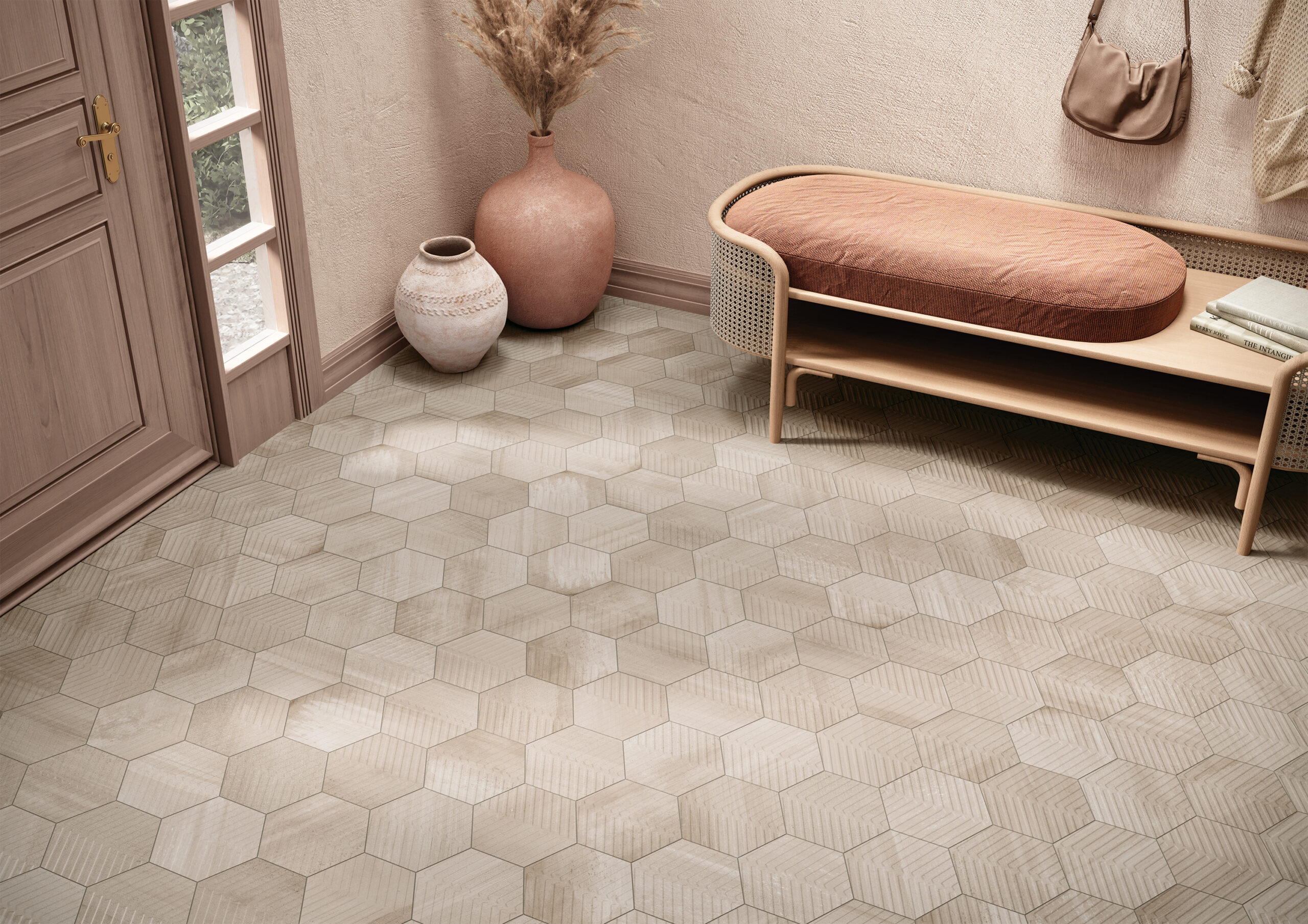
Replacement: How to Match Discontinued Flooring
Unfortunately, floors get discontinued and that can pose challenges to homeowners looking to match the existing flooring, especially if the whole floor does not need to be replaced (remember for future projects, we recommend ordering an extra box to keep on hand if small repairs are needed for this reason).
At Nufloors however, our experts will do their best to find a suitable match or a creative solution:
- With a network of 25 locations across Canada, we will reach out to the other Nufloors location to see if any have the product in stock.
- We will do our best to find a suitable replacement and will do our best to find another product that matches the colour, texture, and style.
- Provide other considerations such as integrating a transition area or pattern from the new floor to the existing one or provide ideas to change the layout in the affected area.
- Use our expertise and years of experience to provide creative solutions. For example, read how Nufloors Camrose exceeded their customer’s expectations when repairing a piece of damaged carpet.
I cannot rave about Nufloors enough. It was a great experience from start to finish. I went in looking to match a small piece of my carpet that my cat scratched. Anyone who knows anything about carpet knows it’s hard to find a match, especially for a small piece. Krystle helped me find something from their discount rolls that was similar enough and suggested we take the carpet from a closet to fix my high traffic area, and then put the similar one in the closet where no one will see it – Such a great idea! She was easy to work with and offered a lot of ideas. Once we had a game plan, she was able to book me in the following week (yaaaay, super quick).
– J. Carty
Gerry and Andre came to do the repair, they were both very friendly and did an amazing job. Andre was honest from the get-go, that it was just a patch, and it wouldn’t look perfect. They completed the repair discreetly, and it looks a lot better than I imagined it would.
If you’re considering Nufloors for a future flooring project, you won’t be disappointed.
Flooring Maintenance Tips
Maintaining your floors will extend their lifespan of them and maintain their appearance. We recommend, regardless of the floor you choose to purchase, that you create a cleaning schedule and be consistent with regular upkeep. Here is how you can keep those floors looking new!
Carpet Maintenance
- Vacuum regularly (at least once a week at the minimum) to remove dirt and dust.
- Note, do not use a beater bar on loop or berber carpets.
- Be vigilant when it comes to spills. Immediate spot cleaning for spills using appropriate cleaners is necessary to ensure it does not stain.
- To maintain the carpet warranty, a professional cleaning is required every 12-18 months. This will remove embedded dirt and allergens.
- Prevention: use doormats to reduce the dirt being tracked in, enact a no shoe policy in the house and rearrange furniture periodically to avoid wear patterns.
Hardwood Maintenance
- Daily sweeping or vacuuming will remove dirt and dust. If vacuuming, make sure to use a soft brush attachment as to not damage or dent the floor.
- Damp mop with a hardwood floor cleaner and make sure to avoid excessive water.
- Prevention: Use area rugs and mats to protect high-traffic areas and felt pads under furniture legs to prevent scratches.
Luxury Vinyl Maintenance
- Regularly sweep or vacuum to remove debris.
- Damp mop with a vinyl floor cleaner as needed.
- Prevention: Use felt pads under furniture legs to prevent scratches and avoid using steams mops which can damage the floor.
Sheet Vinyl Maintenance
- Keep the surface free of dust and dirt by regularly sweeping.
- Damp mop using a mild, non-abrasive cleaner.
- Inspect the floor regularly for signs of wear or damage, i.e. scratches and repair as necessary.
- Prevention: Do not use harsh chemicals or abrasive cleaning tools, also use doormats to minimize the dirt being tracked inside.
Laminate Maintenance
- Sweep or vacuum regularly with a soft brush attachment.
- Damp mop with a laminate floor cleaner and avoid excessive water.
- Clean up spills immediately to prevent damage.
- Do not use abrasive cleaners or tools.
- Prevention: Use furniture pads to prevent scratching and place doormats at entryways.
Cork Maintenance
- Sweeping or vacuuming will remove dirt and dust. When vacuuming, make sure to use a soft brush attachment as to not damage or dent the floor.
- Wipe up spills right away to avoid excessive water to prevent swelling.
- If required, reapply a protective sealant every few years to maintain moisture resistance and appearance.
- Prevention: Use furniture pads to prevent dents and scratches, also avoid high-heel or heavy objects that can damage and dent the surface.
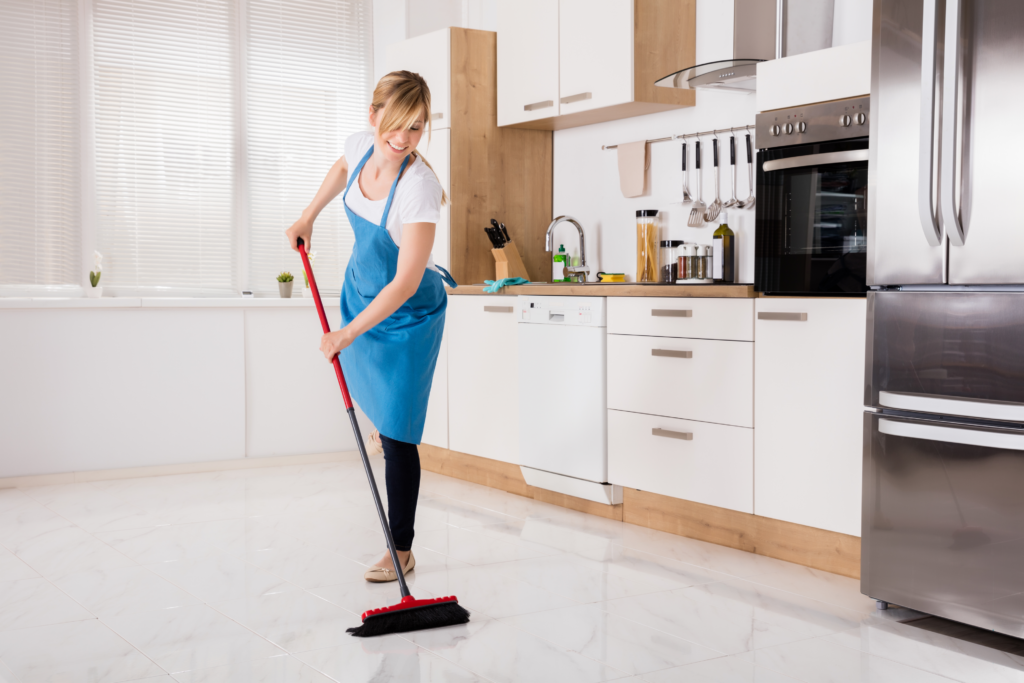
Tile & Natural Stone Maintenance
- Regular sweeping or vacuuming is required to remove dust and dirt.
- Damp mop with a pH-neutral cleaner.
- Clean group lines using a grout cleaner and reseal as needed to prevent staining and to maintain appearance.
- Natural Stone specific: Reseal every 1-2 years to protect the stone from stains and moisture. Also avoid acidic or abrasive cleaners that can damage the stone.
To maintain your warranty, it is best to use the cleaner recommended by each company and always use a PH neutral floor cleaner for all hard surface products. A non PH neutral cleaner may damage the finish of your floor and void the warranty.
Click here to download our full care and maintenance guides!
Conclusion
Choosing the right flooring for your home is a significant decision that not only impacts the aesthetic, but also the functionality and comfort of your space. Each type of flooring comes with its unique set of benefits and drawbacks, tailored to different needs, budgets and lifestyle preferences. As you consider your options think about the specific requirements of each room, the level of traffic and the presence of children and pets. Balancing these considerations with your design preferences will help you select a floor that enhances your home’s beauty and meets your daily needs.
Remember, flooring is an investment that can add value to your home and improve the quality of your life. Whether you opt for the timeless elegance of hardwood, the practicality of luxury vinyl, the durability of tile, or the eco-friendliness of cork, making an informed choice will ensure your satisfaction for years to come.
If you need further assistance or personalized advice, reach out to your local Nufloors experts, who are always ready to help you find the perfect flooring solution. Reach out today to start your Beautiful Experience!

